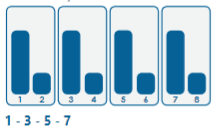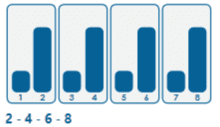Since the very first business of starting cave fires in exchange for furs and hides, the transition from sales to service has plagued organizations. The early people had it right. Grog, the fire starter, sold the sticks and built the fire. His invoice was a grunt and a snort, and Accounts Receivable was immediately funded with a bundle of wheat. But, when it came time to stoke the flames, where was he? He needed a customer service team. Someone to tend to the fire, and when it got lower, build it back up with upselling opportunities. Grog’s 12-stick fire could have quickly become a bonfire capable of smoke signal advertising. “World’s Largest Cave Drawings, Next Exit!”
Picture it, if you will. Your customer team is fielding customer requests, providing that excellent service your clients have come to know and love. Throughout each and every day, some of your clients are dropping hints left and right about their expanding needs and how just one small added service could drastically change their operations. Other customers are being vague, they are shielding their true needs behind what they think your customer service team can offer. After all, the sales process can sometimes be an arduous one. They may not want to go through that whole process again.
You need your front-line service team to not only recognize both scenarios as opportunities but also act on those opportunities, to either capitalize on them or send them to the people who can.
Customer service team members have a big role in your organization. They must deal with challenging situations with absolute confidence while still maintaining proper communications and fostering relationship growth. They must command respect while always showing it to others. But the best customer service team members are ones that are trained in the art of sales. Just like the situations above, customer service representatives that can ease the customer burden (and the sales team’s reselling and upselling burden) excel in their positions and streamline company operations.
How can you identify the inner salesperson in your customer service team? Shameless plug: give them the Omnia Assessment and discover key traits that may lead to the discovery of great sales skills.
The perfect customer service relationship consists of three main aspects that allow the growth of service to clients: organization, communication, and passion. These three, working together, build stronger relationships and lead to the trust needed in upselling opportunities.
Using the Omnia behavioral assessment, customer service team leaders can identify ways to develop their talent’s sales skills. Omnia’s user-friendly 8-column bar graph shows leaders exactly what traits a CSR has so they can tailor their coaching sessions to each rep’s specific needs. Even better, sessions can tap into the rep’s learning style and motivators. One size does not fit all!


Most successful salespeople have a strong column 1 in their Omnia results. This shows them to be naturally assertive. Individuals with a tall column 1 are driven, competitive, and goal-oriented, perfect for sales. With quotas to meet, they are going to do whatever it takes to close deals. However, most service personalities are the opposite, a tall column 2, which means they are naturally supportive, cautious, and eager to help. It makes sense that they are the people who can assist your clients, solve problems, make account changes, and answer questions. It’s a perfect fit. But with that, comes a reluctance to sell. Let’s face it, if they wanted to sell, they would be in sales. Coaching a customer service representative to sell means shifting your definition of selling. It’s important for them to position additional products or services in a way that does not make them feel like they are demanding or pushy. They need to see it as a service, a concrete way to improve the life or business of their customer.
Additionally, salespeople tend to be energized by social interaction, as characterized by a column 3 on the Omnia Assessment. Give them a zoom meeting or a microphone and watch out! Those with a taller column 4 tend to be more reserved. While you want your customer service team to be diplomatic and friendly (no one likes a grump on a service call), column 4 analytics are often better listeners, needs assessors, and problem solvers. They tend to be factual, direct communicators, so coaching on social awareness and rapport building will go a long way towards helping that service rep connect with the customer and thereby make it a little easier to make product suggestions.
Encourage your analytical CSRs to take the first bits of their service interactions to build personal connections with their clients. Doing so builds rapport and trust. If your client knows you care, they are more likely to care about their relationship with your organization.
Both. Definitely both. In looking at the third personality dimension, pace, people with an Omnia column 5 are fast-paced. “Call now!” “Book today!” Everything is urgent. The sale must close, the deadline is always approaching. Ever noticed how salespeople always ask for dates in the decision process? They are time-driven. Conversely, those with an Omnia column 6 are more systematically inclined. “What’s the process?” “How do we move from point A to point B?” Your CSR team is most likely more systematic. CSRs love processes and procedures. So, train your CSRs to act with some urgency when it comes to upselling opportunities. If they hear an opportunity to sell, put a timeline in place at the first start. Train to ask the question, “And when are you looking to make a decision on this?” That helps set the pace while remaining procedural.
Lastly, the final personality dimension is linked to rules and guidelines. Salespeople are comfortable with ambiguity and like more leeway in how they handle sales. While it is important they maintain some sort of respect for the rules of the organization, they are often weaving around and through the rules to try to close the deal. Therefore, salespeople are often an Omnia column 7, where most customer service team members are, you guessed it, the exact opposite with an Omnia column 8. They have a greater reliance on the rules and guidelines. Rules provide comfort and increase confidence in column 8 personalities, plus it’s why your service team is detailed and accurate, which we can all agree is pretty important in service. Especially since the sales team has little to no time to pay attention to the details! Still, empower your CSRs to be a bit bolder when faced with decisions. They will want to take action within the rules, of course, but coaching them to ask questions that might open new opportunities, both with customers and within their respective organizations, is a win for everyone.
Using the Omnia Assessment for coaching your customer service team is an easy investment in the growth of your organization from the inside out. Learn your team’s Omnia personality numbers and use these coaching techniques to make sales interactions just a bit more comfortable for your fire-stokers. Grog is counting on them!